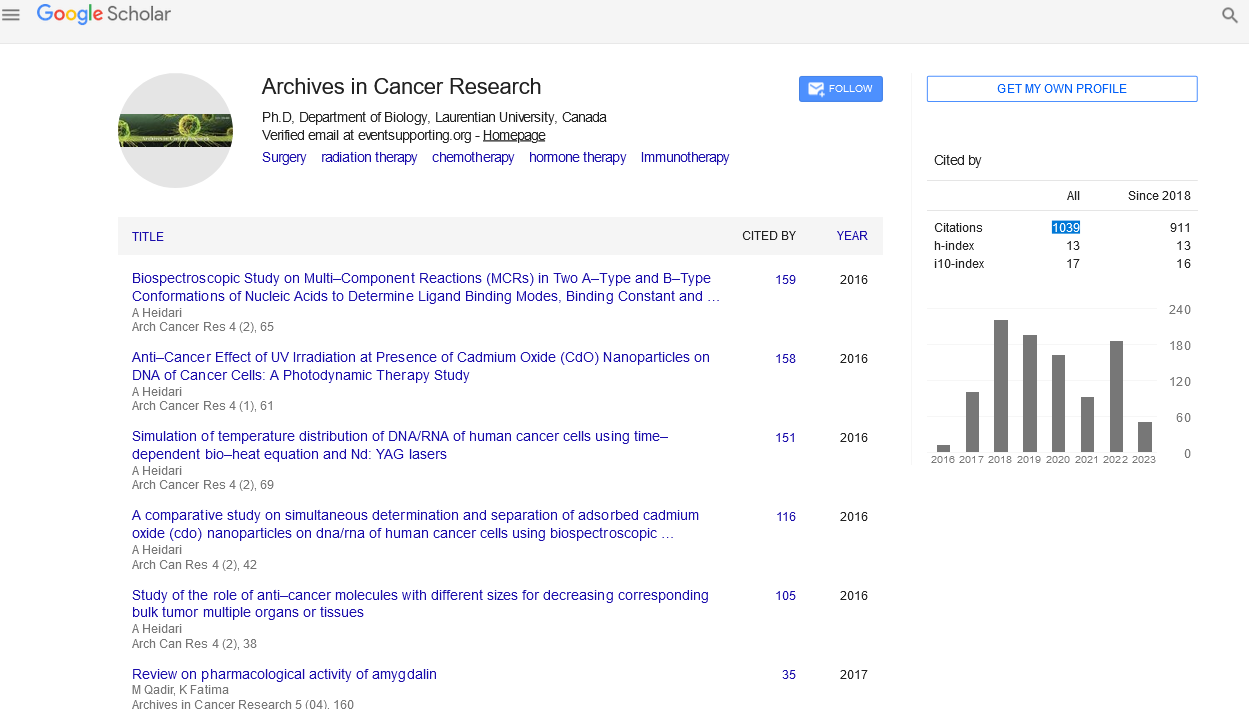Ehab Abou-eladab1,2* and Faten Shehata2
1Faculty of Specific Education, Damietta University, New Damietta City, Egypt
2Basic Science Department, Alfarabi College for Dentistry and Nursing, Jeddah, Saudi Arabia
- *Corresponding Author:
- Ehab Abou-eladab
Faculty of Specific Education
Damietta University
New Damietta City
Egypt
Tel: 009665963352541
Email: ehab10f@gmail.com
Received Date: May 18, 2021; Accepted Date: June 03, 2021; Published Date: June 10, 2021
Citation: Abou-eladab E, Shehata F (2021) Loss-Of-Function Mutation in the RB Tumor Suppressor. Arch Can Res. Vol.9 No.S4:002
The RB tumor silencer quality item (PRB) has been proposed
to connect with in excess of 200 cell proteins.
Notwithstanding the phosphorylation, done by cyclinsubordinate
kinases (CDKs), PRB goes through different
sorts of post-translational alterations. The post-translational
alterations of PRB influence the limiting status with various
effector particles including the E2F family record factors,
proteins with LxCxE themes, and proteasome-related
proteins. This fluctuation of effector particles empowers
PRB to apply pleiotropic capacities. These capacities
likewise vary strikingly relying upon the cell ancestry and
cell setting. Consequently, numerous new surveys have
alluded to PRB as a connector protein dependent on its
capacities, notwithstanding as a pocket protein dependent
on its construction.
Keywords
Tumor suppressor; E2Fs; Cell cycle; Differentiation; Metabolism
Introduction
The deficiency of-work change in the RB tumor silencer quality at tumor inception happens in shockingly couple of sorts of disease. The inactivation of the RB item is regularly found during the movement of normal kinds of malignant growths including prostate, bosom, bladder, and esophageal diseases [1]. Most sanctioned capacity of PRB is to control cell multiplication that is accomplished by forestalling unseemly passage of the cell into the cell cycle. This was tentatively affirmed by cell cycle reemergence upon RB inactivation in a few tissues [2-4].
During undeveloped hematopoiesis, the deficiency of RB in mouse incipient organisms brings about wasteful enucleation and inadequate terminal separation of erythroid cells [5,6]. During skeletal muscle improvement, PRB is needed for the phones to appropriately leave the phone cycle and to finish separation [7]. A myogenic record factor, MyoD, initiates articulation of PRB and Cdkn1a (p21) to implement cells to leave the cell cycle [8]. PRB is additionally needed for redesign of the lamin dots during the myogenic cycle [9]. In the digestive system of mice, when RB is restrictively erased, separation markers showed strange examples, and proliferative tomb cells displayed upgraded expansion [10]. In the focal point, the deficiency of RB changed the declaration of qualities advancing separation, including β-and γ-crystallines. These lacks in separation following PRB inactivation appear to be in any event somewhat because of an imperfection in leaving the cell cycle, which is a basic advance for most separation measures. Furthermore, PRB controls the pluripotency of cells, autonomous of the cell cycle. Therefore, PRB isn't just a cell cycle controller, yet in addition a key factor that controls cell dedifferentiation and change. PRB is additionally ensnared in various assortments of natural occasions like cell passing, DNA harm reaction, cell senescence, genomic unsteadiness, cell digestion, aggravation, and angiogenesis.
PRB has space structures named pocket A, B, and C. These areas independently or in blend add to the actual restricting of numerous variables (effectors) engaged with cell expansion, transcriptional guideline, chromatin alteration, signal transduction, apoptosis, and so forth. In this way, standardly, PRB has been known as a pocket protein. The most widely recognized post-translational adjustment on PRB that modifies its capacities is phosphorylation by kinase edifices comprising of CDK4 or CDK6 and cyclin D, which happens in late G1 stage to early S stage (G1/S change), and the ensuing arrival of E2F record factors elevates movement to the S stage.
PRB is engaged with designated spots and upkeep of mitosis just as in the progress from the G1 stage to the S stage. Chromosomal flimsiness joined by strange axle development and disabled union were additionally seen in PRB-insufficient cells. An atypical articulation of Mad2 brought about by PRB deformities may create a hyperactive reaction to shaft designated spot, causing an unusual request of mitotic occasions and low precision of chromosomal isolation. Determined inactivation of the APC/C by abundance measures of Mad2 may postpone the debasement of securin and cyclin B. Also, PRB controls genomic dependability.
Conclusion
In this review article, we gathered the distributed discoveries of the pleiotropic parts of PRB capacity, and attempted to associate them to the cooperation with various restricting accomplices. Due to the space restriction, we didn't allude to the new advancement in our comprehension of PRB capacities in undeveloped cells, irritation, and other startling parts of metabolic control. We recommend that, considering its solid clinical significance, PRB ought to be constantly concentrated to clarify its capacities identifying with various strides during carcinogenesis, which would be an important asset for malignant growth therapeutics.
38365
References
- Burkhart DL, Sage J (2008) Cellular mechanisms of tumour suppression by the retinoblastoma gene. Nat Rev Cancer 8: 671-682.
- Guo J, Longshore S, Nair R, Warner BW (2009) Retinoblastoma protein (PRB), but not p107 or p130, is required for maintenance of enterocyte quiescence and differentiation in small intestine. J Biol Chem 284: 134-140.
- Mayhew CN, Bosco EE, Fox SR, Okaya T, Tarapore P, et al. (2005) Liver-specific PRB loss results in ectopic cell cycle entry and aberrant ploidy. Cancer Res 65: 4568-4577.
- Sage C, Huang M, Vollrath MA, Brown MC, Hinds PW, et al. (2006) Essential role of retinoblastoma protein in mammalian hair cell development and hearing. Proc Natl Acad Sci U S A 103: 7345-7350.
- Clark AJ, Doyle KM, Humbert PO (2004) Cell-intrinsic requirement for PRB in erythropoiesis. Blood 104: 1324-1326.
- Spike BT, Dirlam A, Dibling BC, Marvin J, Williams BO, et al. (2004) The Rb tumor suppressor is required for stress erythropoiesis. EMBO J 23: 4319-4329.
- Huh MS, Parker MH, Scimè A, Parks R, Rudnicki MA (2004) Rb is required for progression through myogenic differentiation but not maintenance of terminal differentiation. J Cell Biol 166: 865-876.
- De Falco G, Comes F, Simone C (2006) PRB: master of differentiation. Coupling irreversible cell cycle withdrawal with induction of muscle- specific transcription. Oncogene 25: 5244-5249.
- Mariappan I, Parnaik VK (2005) Sequestration of PRB by cyclin D3 causes intranuclear reorganization of lamin A/C during muscle cell differentiation. Mol Biol Cell 16: 1948-1960.
- Haigis K, Sage J, Glickman J, Shafer S, Jacks T (2006) The related retinoblastoma (PRB) and p130 proteins cooperate to regulate homeostasis in the intestinal epithelium. J Biol Chem 281: 638-647.





